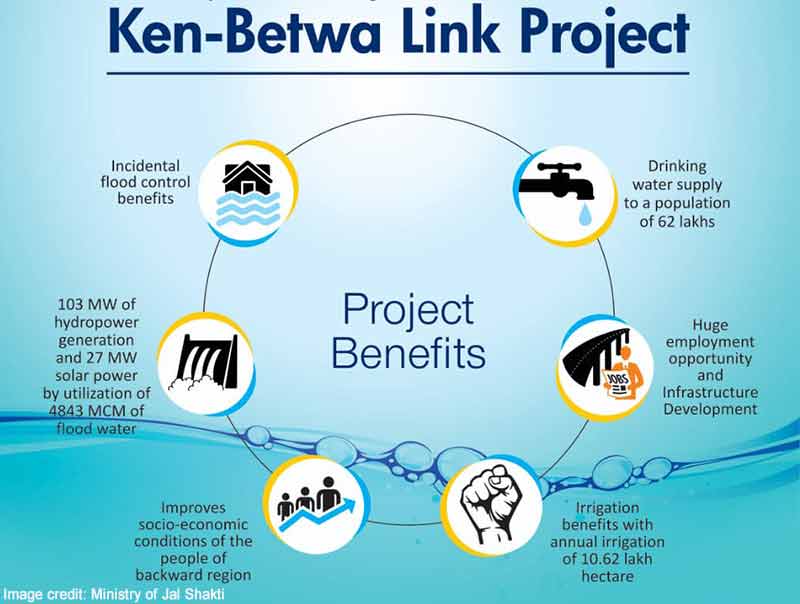- India
- Dec 09
Ken-Betwa river inter-linking project gets Cabinet nod
The Union Cabinet approved the funding and implementation of the Rs 44,605 crore Ken-Betwa inter-linking of rivers project, which will address the water scarcity in the Bundelkhand region spanning across Madhya Pradesh and Uttar Pradesh.
The Union Cabinet has approved a central support of Rs 39,317 crore for the project, covering a grant of Rs 36,290 crore and a loan of Rs 3,027 crore.
An agreement to implement the Ken-Betwa river link project was signed on March 22 by the Jal Shakti Ministry and governments of Madhya Pradesh and Uttar Pradesh.
Ken River
• The Ken River is one of the major rivers of the Bundelkhand region of central India, and flows through two states — Madhya Pradesh and Uttar Pradesh.
• The river originates near Ahirgawan village in Jabalpur district of Madhya Pradesh and joins the Yamuna River near Chilla village in Uttar Pradesh.
• It forms the state boundary between Chhatarpur district (Madhya Pradesh) and Banda district (Uttar Pradesh).
• The river has a total length of 427 km, out of which 292 km lies in Madhya Pradesh, 84 km in Uttar Pradesh, and 51 km forms the common boundary.
• The longest tributary of Ken is Sonar, which is 227 km in length and lies wholly in Madhya Pradesh.
Betwa River
• Betwa or Betravati is a tributary of the Yamuna. Also known as the Vetravati, the Betwa rises in the Vindhya Range just north of Hoshangabad in Madhya Pradesh and flows north-east through Madhya Pradesh and Orchha to Uttar Pradesh.
• It traverses a long distance of 654 km from its source up to its confluence with river Yamuna near Hamirpur in Uttar Pradesh.
• The river has 14 principal tributaries out of which 11 are completely in Madhya Pradesh and three lie partly in Madhya Pradesh and partly in Uttar Pradesh. The Halali and Dhasan Rivers are the important tributaries of the Betwa River.
Ken-Betwa Link Project
• The Ken-Betwa project involves the transfer of water from the Ken river to the Betwa river through the construction of the Daudhan dam (the Lower Orr project, Kotha Barrage) and a canal linking the two rivers (the Bina Complex Multipurpose project).
• The project will ensure an annual irrigation of over 10.62 lakh hectares of land, drinking water supply to a population of about 62 lakh and also generate 103 MW of hydropower and 27 MW of solar power.
• It is expected to be implemented in eight years.
• The Ken-Betwa project will benefit the districts of Panna, Tikamgarh, Chhatarpur, Sagar, Damoh, Datia, Vidisha, Shivpuri and Raisen in Madhya Pradesh and Banda, Mahoba, Jhansi and Lalitpur in Uttar Pradesh.
• The project also comprehensively provides for environment management and safeguards. For this purpose, a comprehensive landscape management plan is under finalisation by the Wildlife Institute of India.
Interlinking of rivers
Interlinking of River (ILR) programme is of national importance and has been taken up on high Priority.
Under the National Perspective Plan (NPP) prepared by the ministry of jal shakti, National Water Development Agency (NWDA) has identified 14 links under Himalayan Rivers Component and 16 links under Peninsular Rivers Component for inter basin transfer of water based on field surveys and investigation and detailed studies. Out of these, Feasibility Reports of 14 links under Peninsular Component and 2 links (Indian portion) under Himalayan Component have been prepared. Draft Feasibility Reports of 7 link projects (Indian portion) of Himalayan Component have also been completed.
Other main river linking projects planned are:
• Damanganga-Pinjal Link Project
• Par-Tapi-Narmada Link Project
• Godavari-Cauvery Link Project
• Mahanadi–Godavari Link Project
• Manas-Sankosh-Teesta-Ganga Link Project.
Manorama Yearbook app is now available on Google Play Store and iOS App Store


